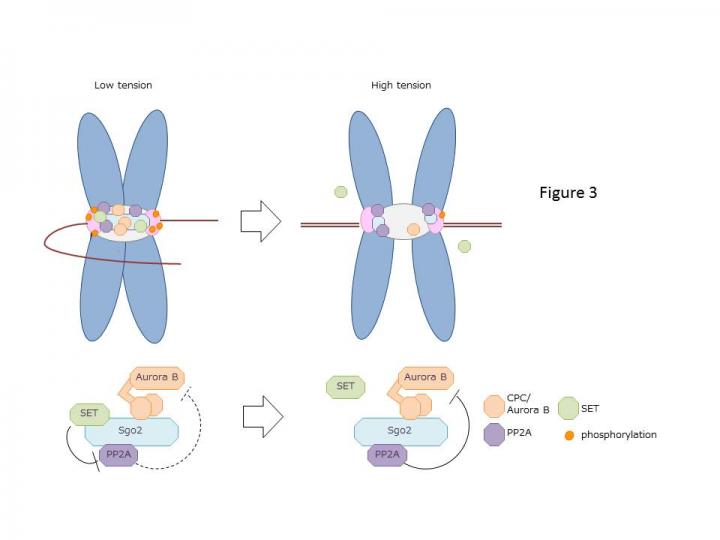
Credit: Terada Laboratory, Waseda University
A Waseda University-led research uncovered the molecular mechanism of how a particular cancer-causing oncogene could trigger an onset of acute myeloid leukemia (AML).
Characterized by symptoms such as fatigue, shortness of breath, and bleeding gums, AML is a type of cancer that starts in the bone marrow and quickly affects blood due to rapid growth of leukemia cells.
This abnormality is caused by mutated genes in chromosomes, turning on oncogenes while turning off tumor-suppressing genes. Mutation occurs when chromosomes are not properly replicated during cell division, and unalignment of even one out the total of 46 chromosomes in a cell causes missegregation.
To prevent such chromosomal abnormalities, a cell precisely controls chromosome distribution to the new-born cells with its tension sensor, which locates the central region of the duplicated chromosomes called the centromere and detects whether the attached microtubule is applying the right among of force to the kinetochore, a protein complex at the centromere.
“Since discovering the enzyme Aurora B kinase (Aurora B) in 1996, we have found that Aurora B plays an integral role as a tension sensor by adjusting microtubule attachment to the kinetochore for chromosome regulation, and that protein phosphatase 2 (PP2A) also acts as a tension sensor by controlling chromosome alignment in correlation with Aurora B,” said Professor Yasuhiko Terada of Waseda University in Tokyo. “However, the system is extremely complex, and its molecular mechanism was not well understood.”
In their latest study published in the Journal of Cell Biology, Terada’s team found that SET/TAF1, a proto-oncogene of AML, also functions as a tension sensor by fine-tuning the enzyme activities of Aurora B and PP2A. As the three tension sensors interact with each other, the replicated chromosomes are distributed evenly to the new-born cells and prevent chromosome abnormalities.
“Protein encoded by the SET oncogene (SET) maintained Aurora B activity by inhibiting the PP2A activity at the centromeres. Also, it was intriguing to observe that though SET inhibits activity of PP2A to allow a high Aurora B activity and adjust microtubule attachment when chromosomes are not aligned, it detaches from the kinetochore and decreases the activity of Aurora B to stabilize attachment of microtubules to the kinetochore when chromosomes are aligned,” Terada explained.
Additionally, experiments using molecular biological techniques investigated the oncogenic function of SET to study whether centromere localization of SET is essential for chromosomal abnormality. Results showed that SET disrupts the tension sensor mechanism at the centromere, supporting previous research that report how abnormal activity of Aurora B is observed in many cancer cells, and how overexpression of Aurora B in normal cells induce chromosome misalignment.
Though many questions remain unanswered to fully understand the molecular mechanism of the tension sensor, Terada believes that this discovery could serve as a baseline for further investigation to elucidate the molecular mechanism of cancer malignancy by chromosome missegregation and the development of leukemia, as well as to create anticancer drugs that target SET and Aurora B.
###
Article Information
Paper: “Aurora B kinase activity is regulated by SET/TAF1 on Sgo2 at the inner centromere”
DOI: 10.1083/jcb.201811060
Author: Yuichiro Asai, Koh Fukuchi, Yuji Tanno, Saki Koitabashi-Kiyozuka, Tatsuyuki Kiyozuka, Yuko Noda, Rieko Matsumura, Tetsuo Koizumi, Atsushi Watanabe, Kyosuke Nagata, Yoshinori Watanabe, Yasuhiko Terada
Published in the Journal of Cell Biology on September 16, 2019
About Waseda University
Located in the heart of Tokyo, Waseda University is a leading private research university which has long been dedicated to academic excellence, innovative research and civic engagement at both the local and global levels since 1882. Today, the student body at Waseda is approximately 50,000, over 7,900 of whom are from overseas, hailing from 125 countries. To learn more about Waseda University, visit https:/
Media Contact
Jasper Lam
[email protected]
Original Source
https:/
Related Journal Article
http://dx.




